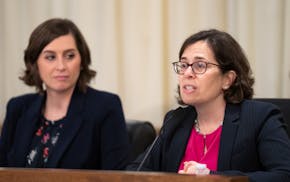Earth lovers, here's today's quiz:
Which sector of the Minnesota economy is spewing the most planet-warming carbon into the atmosphere? Is it A) transportation; B) electricity generation; or C) agriculture, forestry and other land uses?
If you picked A, you get an A — and you'll likely agree that it was a good thing that the chair of the Minnesota House Transportation Finance and Policy Committee was in Glasgow, Scotland, for the recent United Nations climate change Conference of the Parties, known as COP26.
Rep. Frank Hornstein, DFL-Minneapolis, was one of only two state legislators who joined more than 60 other Minnesotans at COP26. They went in search of inspiration for Minnesota's next steps in the fight against climate change. (The other legislative seeker was Rep. Patty Acomb, DFL-Minnetonka, chair of the House Climate Action Caucus.)
If a heightened sense of urgency and awareness of Minnesota's duty of global stewardship qualify as inspiration, I'd say Hornstein found it. That's what he conveyed to me in a debriefing last week.
"What I took from Glasgow is that we all have to be global citizens," he said. "We have to immediately, urgently cut greenhouse gases at every possible place, across the board. If urgent action is not taken, we face terrible destruction.
"These issues do not stop at any state's or nation's border. It's incumbent on us to make sure Minnesota is bringing gas emissions down."
You may be asking: What difference could little Minnesota make? That leads to quiz question 2:
Which U.S. region emits the largest share of greenhouse gases into the atmosphere? Is it A) the population-dense Northeast; B) the oil-field states of Texas and Oklahoma; C) the wildfire-prone West; D) the big air conditioner users in the Southeast; or E) the Midwest, including Minnesota?
If you chose any region but E, give yourself an F. And do your homework on the climate-menacing impact of Midwestern manufacturing, agriculture, building heating and cooling, electricity generation and Minnesota's biggie, transportation.
Put those 12 states together as a hypothetical independent nation, advises J. Drake Hamilton of the Minnesota-based nonprofit Fresh Energy, and it would be the world's sixth-largest emitter. This region's duty to cut emissions is real.
Even in the transportation realm, COP26 wasn't much of a trade show. It didn't give Hornstein much to report on new whiz-bang technologies for cutting carbon emissions.
Rather, Hornstein said, COP26 "reminded us that the biggest issues we face in cutting emissions are not technical. They are political. We have the know-how to solve this problem. Now we have to have the spirit and the political will."
He knows what policies he'd like the Minnesota Legislature to set into statute. He wants to incentivize the purchase of electric vehicles and subsidize the installation of charging stations throughout the state. The new federal infrastructure bill includes $68 million for charging stations in Minnesota. Hornstein says that sum is welcome, but not sufficient.
He would also like to set in law a goal for reducing vehicle-miles traveled. That would lead, in turn, to stepped-up state and local investments in zero-emission transit, bike lanes, pedestrian paths and broadband, all of which help citizens minimize driving.
And despite the rising price of gasoline, Hornstein hasn't given up on the notion of a boost in Minnesota's original carbon tax — the highway-dedicated gas tax. Though he knows it's projected to be a declining source of revenue as electric vehicle sales increase ("I hope so!" he said), it still pays for road improvements, freeing other funds for climate-related measures.
One last quiz: Which of these five states has the lowest per-gallon state gas tax? Is it A) Idaho; B) Indiana; C) Utah; D) Iowa; or E) Minnesota?
Cue the Rouser. It's Minnesota. So much for the high-tax reputation of blue-state Minnesota compared with a passel of its red-state counterparts.
Hornstein's policy wish list might be called the unfinished business of the 2021 Legislature. His ideas were all introduced but omitted from the bill he and his Senate committee counterpart, Sen. Scott Newman, R-Hutchinson, assembled. That bill got high marks for bipartisan compromise. But it can't be called a turning point in this state's contribution to minimizing climate change.
For that turn to happen, representative democracy will have to work better in these parts than it has in the past several sclerotic decades. The same can be said for representative democracy wherever it is practiced.
The unfolding climate crisis is presenting democracy with a very high-stakes test. Can the will of the people be politically harnessed in time to preserve the planet's livability? Or will supposedly democratic governments instead heed the voices — and the money — of polluters?
Hornstein was heartened by the visible presence in Glasgow of those who have often been ignored by democratic governments, particularly the young and Indigenous. But when it was time to decide the language of COP26's final agreement, the doors were closed and a draft's call to "phase out" coal consumption became "phase down."
"If this was indeed our last best chance" to avoid catastrophic climate changes, as some politicians said as COP26 convened, "we are in trouble," he said.
Yet a legislative session is set to resume on Jan. 31. A state election is on tap next year. COP27 is set for November 2022 in Egypt. Unlike today's quiz, democracy's climate test isn't finished yet.
Lori Sturdevant is a retired Star Tribune editorial writer. She is at lsturdevant@startribune.com.

Olson's cheers and jeers: When OLA speaks, it's best we listen
Opinion: The unjust detention of Doğukan Günaydın
Dabney: This 420 is going to be lit

